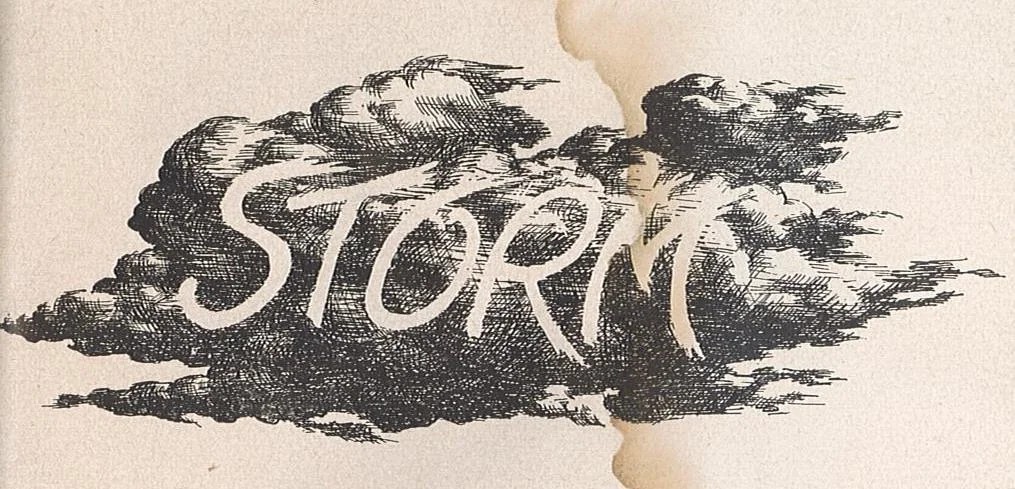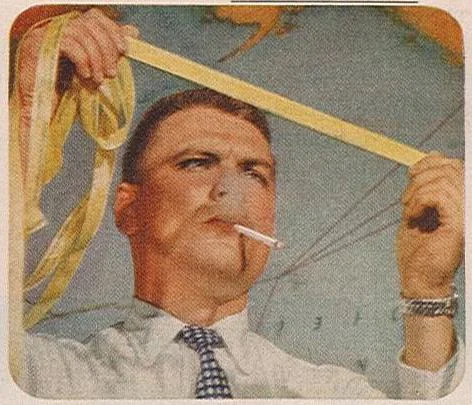Hurricane Carla, 1961
Image of the radarscope at Galveston, as Hurricane Carla approached the Texas coast, September 10, 1961. Digitized by the NOAA Photolibrary. Originally published in Monthly Weather Review, December 1962, p. 515.
Radar has become so central to the way we see severe storms that it’s hard to imagine the time before it. The brilliant swirling bands and angry red spots playing over maps of the Gulf Coast featured on TV broadcasts and webpages this week told us the intensity of Hurricane Harvey at a glance. But an earlier devastating Texas hurricane taught Americans how to translate the shining mess of reflections on a radarscope into an intelligible picture that sparks concern and action. Remarkably, the original video still exists of newsman Dan Rather and the meteorologists at the US Weather Bureau office in Galveston initiating this new era.
Hurricane Carla approached Texas over the Gulf of Mexico in early September 1961, a significant storm well-tracked by the Weather Bureau’s evolving surveillance systems, including aircraft reconnaissance and reports from ships. The Weather Bureau’s Van Rockne, chief of observations in Washington, decamped to Galveston in advance to set up a radio-TV broadcast center to provide warnings. Some 200 TV and radio stations on the coast and inland were connected.
Dan Rather made the most of the forewarning. The news director for KHOU-TV in Houston brought a camera crew to Galveston and delivered live updates over the course of forty hours as the storm approached. He interviewed Rockne, asking him to explain why people needed to remain cautious as the eye passed overhead. CBS saw a dramatic story unfolding, and patched Rather’s reports through to a nationwide audience.
Rather and Rockne worked together to explain the images produced by the Bureau’s WSR-57 radar set. Rather had the inspiration to lay a transparent map of the coastline over the radarscope, thus giving viewers a familiar vantage-point from which to appreciate the immensity of Carla. “When I said, ‘this is the actual scale, there’s the state of Texas, one inch equals fifty miles,’ you could hear people in the studio gasp. Anyone with eyes could measure the size of it,” he recounted much later.[1]
A promotional film documenting KHOU’s activities in 1961. The section on Hurricane Carla begins at 1:18, while the kinescope recording of Rather’s live broadcast showing the radar starts at 3:30. Film digitized by the Houston Public Library Digital Archives and accessible here.. This embeddable file was uploaded to YouTube by user Mrk Cntrmn.
It was a crucial moment in TV history. Hundreds of thousands of people choose to evacuate. TV and radar became central to people’s experience of the storm. According to one description, “the Weather Bureau radarscope became a familiar sight in Texas homes and Red Cross shelters, where it was watched on portable and battery-powered TV sets, until the video transmission was lost,” as the storm knocked out the connection.[2]
Dan Rather was not the first to put radar on TV. TV weather historian Bob Henson notes that a number of coastal TV stations had their own radars that they televised during the late 1950s, and that Jim Fidler at WLWT in Cincinnati had made radar a staple of his severe weather coverage by 1955.
But Rather’s innovation was an important part of transforming meteorological research device into a tool for public warning and communication. The images on 1950s radar scopes were placeless; reflections of events high in atmosphere, divorced from locations familiar to ground-dwelling human beings. Introducing a map brought the weather down to earth, re-connecting storms to the places where people live.
A c. 1961 film produced by the Weather Bureau explaining how to interpret the radar image of Hurricane Carla. I don't have a clear sense of who may have viewed this film. Film uploaded by NOAA.
Learn More
- Robert Henson, Weather on the Air: A History of Broadcast Meteorology (American Meteorological Society, 2010): 154-163.
- Mark Monmonier, Air Apparent: How Meteorologists learned to map, predict, and dramatize the weather (University of Chicago Press, 1999): 137-154.
- Roy Popkin, The Environmental Science Services Administration (Praeger, 1967): p. 183.
Image Sources
- Radarscope at Galveston, Texas, September 10, 1961. Digitized by the NOAA Photolibrary. Originally published in Monthly Weather Review, December 1962, p. 515
- "Dan Rather videotape ca. 1961 probably Hurricane Carla," produced by KHOU-TV, and digitized and hosted by the Houston Public Library Digital Archives.
- "US Weather Bureau: Hurricane Carla," film by US Weather Bureau, c. 1961. Digitized and uploaded by NOAA.
Citations
[1] Dan Rather with Marty Herskowitz, The Camera Never Blinks (William Morrow, 1977) p. 49, Quoted in Henson, Weather on the Air, p. 154.
[2] Roy Popkin, The Environmental Science Services Administration (Praeger, 1967): p. 183.






